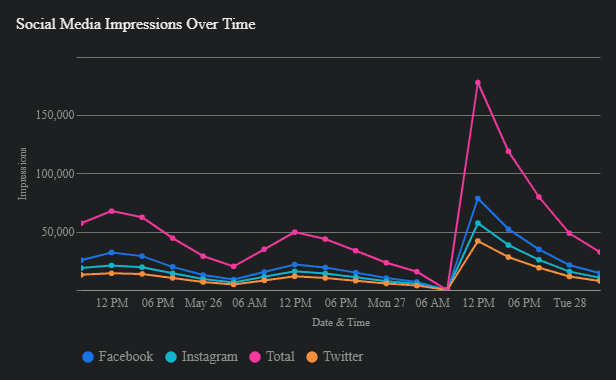Imagine scrolling through your feed and seeing a new brand pop up not once but multiple times. Each post, a mosaic piece, builds a picture of something bigger—a brand. Social media impressions shape the environment where brands rise to recognition or fade into the background.
To understand the impact of social media impressions, we have to first look at what they are and how they’re measured. Knowing the importance of impressions is one thing, but measuring their frequency and impact across social media platforms is another critical skill in a marketer’s toolkit.

Image by pikisuperstar on Freepik
Before we explore how social media impressions impact brand awareness and discuss engagement strategies, let’s first answer the following question:
What are Social Media Impressions?
Social media impressions reflect the potential touchpoints between content and users on social media platforms. They represent the total number of times a social media post appears in someone’s timeline or newsfeed, whether or not the user actively engages with it.
This metric serves as a Key Performance Indicator (KPI), demonstrating how regularly and widely a message is broadcasted. By using impressions as a KPI, marketers can quantify the potential audience their content reaches, and infer the extent to which their marketing campaigns are penetrating the user base of a social media platform.
Why are Social Media Impressions Important for Brand Awareness?
Social media impressions spotlight the frequency at which your content intersects with potential customers. If you know which of your posts get pushed by the algorithm to more users, then you can plan similar content in the future to reach a wider audience.
When examined alongside engagement metrics such as likes, shares, and comments, impressions provide a more comprehensive view of how well your content resonates with your target market.
Even if your posts are not getting much engagement, repeated exposure leads to improved brand recognition, which, in return, boosts brand awareness.
How are Social Media Impressions Measured?
Social media impressions are commonly displayed in analytics dashboards integrated into social media platforms. They can also be measured using third-party social listening tool such as Mention, which offer insights into audience demographics, engagement, and overall content performance.
While integrated analytics dashboards do offer a range of useful metrics, social listening tools have more customizable reporting options. They aggregate data from multiple sources and come with advanced filtering and segmentation capabilities.
For example, when setting up the dashboard on your social listening tool, you can choose which topics and competitors you want to monitor. The most commonly used metric for competitor benchmarking is Share of Voice (SOV), which measures the percentage of online conversations or mentions your brand receives compared to its competitors within a specific industry or topic.
Together with impressions, SOV provides the full picture of your brand’s online visibility, enabling more informed strategic decisions.
Role of Social Media Platforms in Generating Impressions
Every social media platform has its unique algorithm that takes your content and slots it into user feeds, accumulating impressions each time it is displayed. These impressions provide a measure of your content’s reach and visibility and are key indicators for evaluating how well your brand’s campaigns are received by the platform’s audience.
To capitalize on this and create a strong content strategy that maximizes impressions, you should focus your efforts on understanding the algorithms that dictate content dissemination on each platform. You can do this by monitoring popular content by other brands or users, as well as analyzing how well your posts fare in comparison.
Popular Social Media Platforms for Brand Exposure
In order for your brand to gain more exposure, you have to learn the ins and outs of popular social media platforms such as YouTube, X, Instagram, TikTok, LinkedIn, and Facebook. Of course, you always have the option to make your own social media app if your goal is to grow brand awareness by creating a new user experience. However, even if you do end up creating your own social media app, you will still need to be active on the aforementioned platforms to promote it.
Each social media platform has its own ecosystem, characterized by unique content preferences and engagement patterns. To grow your brand’s exposure, you have to tailor your content (video, text, or images) to the specific audience native to that platform.
To illustrate, the same user who liked your aesthetic reel on Instagram might skip the same video on TikTok because the TikTok community thrives on trends, humor, or authenticity, which may not align with the aesthetics-focused content often found on Instagram.
Comparison of Impressions Across Different Platforms

A side-by-side comparison of impressions across social media platforms can provide valuable insights for marketers. Focusing on platforms that yield the highest level of impressions can be a strategic choice because it can direct your resources where they seemingly have the most significant impact.
However, you have to keep track of what type of people each platform is helping you reach and whether these impressions generate quality interactions.
Just because your content is getting viewed more, it doesn’t mean that it’s seen by the right audience. You have to continuously monitor trends and change audience preferences across channels so you can fine-tune your social media strategy to a point where it gains a lot of impressions from the right people.
Target Audience and Potential Customers
Social media marketing has revolutionized how brands target their audiences, allowing for direct engagement with potential customers. With features like Instagram stories and reels, Facebook live videos, X polls, TikTok advertising, and Snapchat ads, businesses have many tools at their disposal to increase brand awareness in creative and interactive ways.
One of the best ways to turn your target audience into potential customers is through user-generated content (UGC), which refers to any content, such as videos, photos, reviews, or posts, created and shared by users rather than by the brand itself.
Many paying customers turn to social media to share their experiences with brands, and if they have positive experiences with your brand, they automatically become your brand advocates. UGC is effective and garners more impressions because other users perceive it as organic, and they are more likely to interact with it than with posts or ads coming from your brand accounts.
Analyzing impressions to understand target audience behavior and preferences
You have to consistently track and analyze posts with higher impressions to understand user interaction patterns and preferences. High impressions usually signal that your piece of content resonates well with the platform’s audience, but to correctly judge that, you have to single out your top posts based on impressions and analyze the type of engagement they get.
Do they get more likes or comments? Do they prompt users to tag other users in the comments? Are the comments positive or negative? Do your posts get saved, shared in DMs, or stitched/duetted by other creators? Are some content types leading to more conversions than others?
The analysis of posts with high impressions is not a static task but a continuous process that feeds back into your brand’s marketing DNA, helping you align your offerings with what truly engages your target audience.
Social Media Campaigns and Marketing Strategy
Once you understand what resonates well with your target audience, you can plan your marketing strategy and social media campaigns.
Besides impressions, another key metric you should look at is reach. Reach refers to the total number of unique users who have encountered the campaign content. It represents the number of people who have been exposed to your posts.
To be able to gauge the success of your social media campaigns and overall marketing strategy, you have to combine reach and impressions with conversion metrics so you can quantify how well these strategies translate into actual business results.
Your content might be reaching a lot of people, but is it making them take the extra step to download your PDF or flip book, sign up for your newsletter or webinar, or purchase your product after they see your social media content?
Align these social media metrics with the business goals that you track.
Strategies for designing effective social media campaigns
You have to design your social media campaigns with shareability and engagement in mind. Here are six strategies to keep in mind:
- Consistent Branding and Posting: Regular content updates with consistent branding enhance recognition and keep your audience engaged.
- Diversified Content Types: Incorporating a mix of formats like videos, images, and carousels can attract wider attention spans and preferences.
- Engagement Tactics: Contests and giveaways invite interaction, which can exponentially increase a brand’s visibility. However, the interactions they attract are often short-lived because many users will unfollow your brand profiles after you announce the winners.
- Community Building: Creating and participating in conversations, as well as encouraging user-generated content, can promote a sense of community around the brand. To be effective and increase brand impressions, your community should feel as if they are a part of a big brand story.
- Influencer Partnerships: While you can build a brand story on your own, collaborating with the right influencers can speed up the process because they introduce a layer of authenticity that can extend your reach to a broader and more engaged audience, multiplying the impressions of your content. Currently, nano influencer marketing is on the rise because nano influencers have niche audiences that deeply trust them. To optimize these collaborations, an effective influencer marketing strategy involves carefully selecting influencers whose creative vision aligns with your brand ethos, ensuring a harmonious partnership that resonates with audiences.
- Paid Social Media Advertising: You can tailor your social media campaigns to directly reach people who are most likely to be interested in your brand through paid ads. However, you have to be careful not to overdo it. Nowadays users aren’t very fond of paid ads because they feel ads disrupt their online experience. Balance is key when incorporating paid advertising into your strategy; it should complement your organic content rather than overpower it.
Measuring the Impact of Social Media Impressions on Brand Awareness

Measuring impressions is not just about quantity but also the potential for repeated exposure, which can lead to higher brand recall and recognition. Short-term surges in impressions can reveal which content is trending, while a long-term analysis may highlight enduring topics of interest to a brand’s audience.
The impact of social media impressions, however, can be properly assessed in combination with other metrics such as engagement rate and conversion rate. Is your goal simply to have more people talking about you or doing a specific action such as making a purchase?
Measuring engagement rate and its impact on brand awareness
If your goal is to have more people talking about your brand and engaging with your content, then assessing engagement metrics such as likes, comments, and shares, will shed light on how well your content resonates with your audience.
A high engagement rate is a clear indicator that the social media strategy in place is effective and the content is both relevant and captivating to the target market. These interactions reflect a positive user experience and organically amplify the brand’s message.
To maximize the impact of engagement on brand awareness, consider the following measures:
- Analyze Content Performance: Evaluate which types of content yield the highest engagement to inform future content creation.
- Customer Feedback: Harness insights from comments and direct messages to understand customer needs and refine marketing approaches.
- Benchmarking: Use comparison infographics to compare engagement rates against industry standards or past performance to set realistic and ambitious goals.
Analyzing Conversion Rate and Its Correlation to Impressions
If your goal is to direct users towards a specific action as part of your lead generation strategy, then you should focus on conversion rates. This metric shows how effective your marketing strategies are in motivating users to take the desired action such as filling out a form, signing up for a newsletter, or making a purchase.
A high conversion rate suggests that your content is reaching the right audience and is persuasive enough to move them through your well-designed sales funnel. You must consistently track this metric to understand how well your content matches up with your audience’s interests so you can fine-tune your marketing approaches for future campaigns.
The Role of Awareness Campaigns in Brand Building
Brand building starts with brand awareness and the focus of your brand awareness campaigns should be to introduce audiences to your brand’s core values and identity and to create memorable experiences for them. When a brand becomes known for providing positive experiences, it will attract new customers and reinforce the loyalty of existing ones.
How social media impressions contribute to awareness campaigns
Social media impressions inform marketers of which types of content and brand messages can exponentially enhance brand visibility and engagement. By using this data, they can create and share similar high-quality and compelling content that will maximize their brand’s social media reach and impact.
Awareness campaigns require a high level of visibility to build trust, credibility, and a sense of reliability around a brand—if people see a brand consistently being talked about, they are more likely to believe in its value.
When a social media post resonates with target audiences, it lingers longer in newsfeeds and it is more likely to be shared, which results in more impressions and increased brand awareness.
Creating positive experiences for customers through brand awareness
We mentioned the importance of cultivating memorable experiences that resonate with customers, but how can you achieve that positive outcome? Your first step should be to engage with your audience in a way that shows them that you’re listening to their feedback and you’re responsive.
When a business demonstrates that it values customer opinions, it humanizes the brand, making users more likely to gravitate toward it. Promptly responding to customer inquiries, especially on public platforms, can turn a potential crisis into a showcase of the brand’s dedication to social media customer service.
Increase Social Media Impressions Through Meaningful Content
To understand the true impact of brand awareness campaigns, particularly those implemented via social media, brands must consistently track various metrics.
Key metrics like reach, engagement, and impressions paint a detailed picture of a campaign’s success and the brand’s influence. Meanwhile, conversions are tangible indicators of how social media engagement translates into website visits and, optimally, sales.
If your goal is to increase your social media impressions and transform them into positive brand awareness, make sure that your content is crafted with intention, authenticity, and empathy. Aim to create a lasting impression – one that transcends screens and resonates deeply with your audience.

